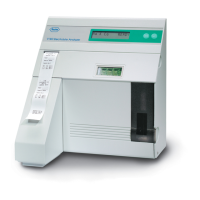vii
Elevated calcium, hypercalcemia, may be present in various types of malignancy, and calcium
measurements may serve as biochemical markers. In general, while ionized calcium may be slightly
more sensitive, either ionized or total calcium measurements have about equal utility in the detection
of occult malignancy. Hypercalcemia occurs commonly in critically ill patients with abnormalities in
acid-base regulation and losses of protein and albumin, which gives a clear advantage to monitoring
calcium status by ionized calcium measurements.
Patients with renal disease caused by glomular failure often have altered concentrations of calcium,
phosphate, albumin, magnesium and pH. Since these conditions tend to change ionized calcium
independently of total calcium, ionized calcium is the preferred method for accurately monitoring
calcium status in renal disease
3
.
Ionized calcium is important for diagnosis or monitoring of: hypertension management,
parathyroidism, renal diseases, inadequate calcium intake, vitamin D monitoring, dialysis patients,
cancer, pancreatitis, effect of diuretics, malnutrition, kidney stones, multiple myeloma and diabetes
mellitus.
Lithium
Lithium is a monovalent alkali metal which is usually absent in the human body. It is used in the
treatment of manic depression psychosis. The drug has proven highly effective in its intended use but
some clinically significant complications have been associated with its use. Lithium binding to the
plasma proteins is less than 10% and its half life is 7 - 35 hrs. It is mainly eliminated from the body by
urine (95%).
Lithium has a very narrow therapeutic range. Initial dosing is aimed at between 0.80 to 1.20 mmol/L
and the long-term maintenance level is 0.60 to 0.80 mmol/L. The concentration of lithium in serum
during therapy is closely monitored, because lithium is acutely toxic with concentrations that are
slightly higher than the above therapeutic range.
Urine Electrolytes
The electrolytes present in the human body and also ingested daily from food are excreted from the
body in a natural circulation via the renal system, into the urine. Measurement of electrolytes in
excreted urine gives important information about the efficiency of the kidneys and other pathological
situations. Urine examinations can be made on a random urine sample or for a quantitative determina-
tion on a 24 hour collected urine sample. The quantity of electrolytes excreted per day can be deter-
mined by multiplying the measured concentration (mmol/L) with the total quantity of urine excreted in
one day.
3
Burritt MF, Pierides AM, Offord KP: Comparative studies of total and ionized serum calcium values in normal
subjects and in patients with renal disorders. Mayo Clinic Proc. 55:606, 1980.

